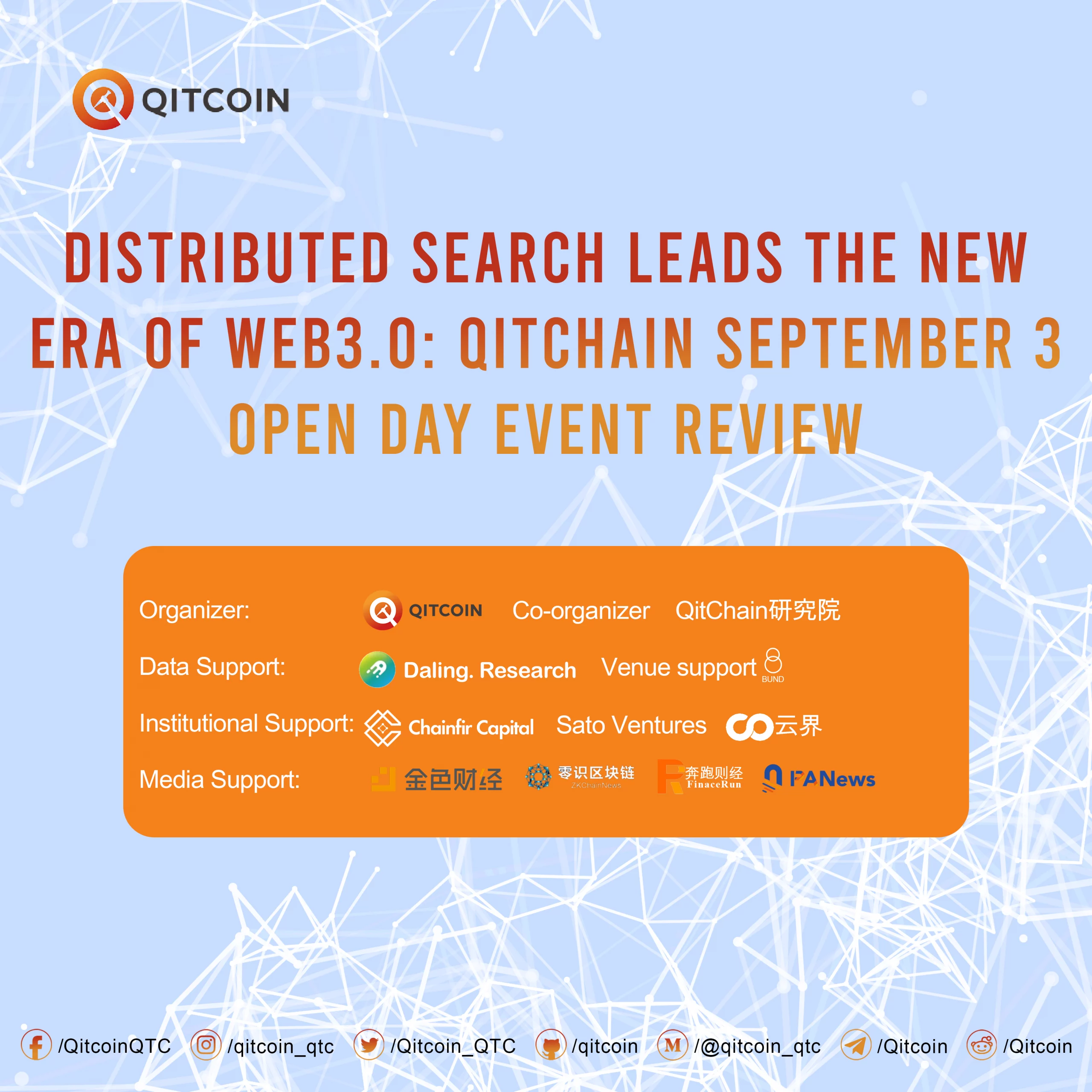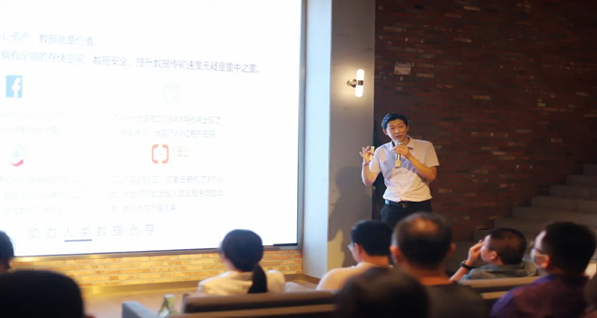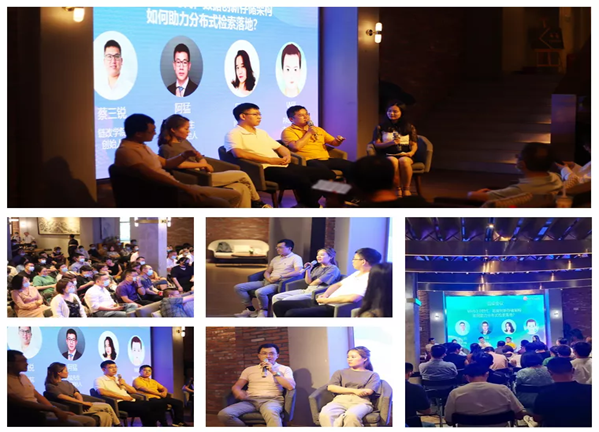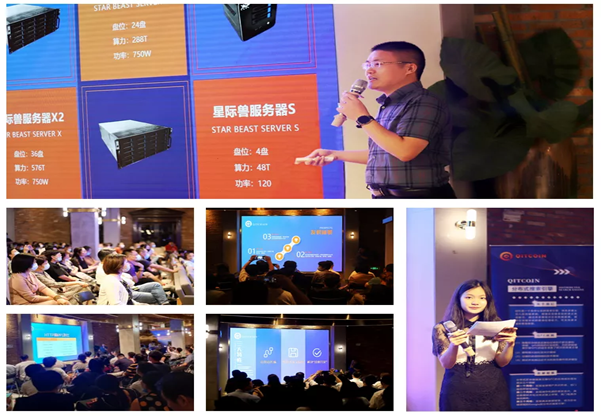
Distributed search leads the new era of WEB3.0: QitChain Event
New era of WEB3.0: QitChain Event
On Sep 3, 2021, a splendid blockchain industry exchange meeting distributed search leads the new era of WEB3.0 at the beautiful Shanghai Bund 8. This event was hosted by QitChain, co-organized by QitChain Research Institute, and supported by Daling research data.
Supporting organizations for the event include Chainfir Capital, Sato Ventures, Tiger Block Fund, Yunjie, Mr. A Meng, Graphene Capital, Chain Reform Academy, and also there are media support such as Golden Finance, Mars Finance, Chain Dede, PANews, Gyro Finance, Coin Express, Carbon Chain Value, Zero Sense Blockchain, Run Finance, Interstellar Vision, Bihu, Lichang, Xikey Finance, Western Finance and other media. The guests invited to this event include Zhang Yonghua, partner of Bojiang Capital, Tong Ming, business director of Hangzhou Yunjie Network Co., Ltd., Cai Sanrui, founder of Chain Reform Academy, Mr. A Meng, founder of brand A Meng, Ms. Flora, founder of ICP Foundation, Mr. Will, head of PAB Asia Pacific ecology.

Today, when the concept of Web3.0 is constantly being mentioned, what are we experiencing? Technological changes continuously promote the rewriting of the life trajectory of ordinary people. History has never stopped its pace. However, objective history reflects vastly different subjective experiences in different people.
As participants, how can we use investment activities as an opportunity to keep up with the trend of the times? Can active participation in emerging industries bring us substantial benefits? Nearly a hundred participants and invited guests at the scene started this theme exchange meeting for distributed search to lead the new era of WEB3.0 around these issues.
Sharing 1: “Investment Choices under the Trend of the Times”

After the event started, Mr. Zhang Yonghua, a partner of Bojiang Capital, first shared the industry. The topic he shared was “Investment Choices under the Trend of the Times”.
Mr. Zhang Yonghua spoke from the logic of capital investment to the origin of the idea of decentralization, then from WEB1.0 to the evolution of WEB2.0, and then to the changes in the era of WEB3.0, and then focused on analyzing the data caused by the current social centralized network There are many problems in the storage field and the changes these problems will face. Finally, Mr. Zhang Yonghua summarized the three criteria of his investment logic:
1. Just need for happiness (whether it meets the most extensive real needs)
2. Ceiling theory (whether there is a sufficiently high ceiling)
3. Long tail effect (whether it has the ability to continuously create value)
According to Mr. Zhang Yonghua’s sharing, we know: Although the future may be unlimited, we can be sure that Web3.0 can change the power imbalance caused by the current centralized network and put the power of information release back into the hands of individuals.
The world economy supported by Web3.0 is a data economy, and all data-based applications are inseparable from storage. Information storage will become the foundation of the future economic building, prompting profound changes in the economy and society. So, how does distributed storage empower the Web3.0 era?
Sharing 2: “Meet the New Opportunities of Distributed Storage”

Afterwards, Mr. Tong Ming, Commercial Director of Hangzhou Yunjie Network Co., Ltd. gave a speech on the theme of “Meeting the New Opportunities of Distributed Storage”.
Mr. Tong Ming analyzed the current domestic policy background, and then shared the market environment, data management and overall solutions of WEB3.0, and said that in the era of WEB3.0, distributed search will be a good entry point.
According to Mr. Tong Ming’s sharing, we can feel the explosion of storage and search demand. However, whether it is storage or search, it is not based on its own problems.
In the future, we will not only face the storage itself, but also go beyond the storage itself to solve a series of problems such as the integration of technologies and the construction of incentive layers. Therefore, they are all saying that distributed search is good, and landing is the key!
Round table: “In the WEB3.0 era, how does the innovative data storage architecture help distributed retrieval land?
In order to give everyone a more detailed understanding of the current development status and development direction of distributed storage and retrieval, the second session of this exchange meeting-the round table meeting.
The topic of discussion is “In the WEB3.0 era, how does the innovative data storage architecture help distributed retrieval land?”. The guests participating in the roundtable discussion included Cai Sanrui, the founder of the Chain Reform Academy, A Meng, the founder of Mr. A Meng, Ms. Flora, the founder of the ICP Foundation, and Mr. Will, the head of PAB Asia Pacific ecology.

The round table first discussed the underlying technology. Since last year, the IPFS distributed storage technology has been very hot. The industry generally believes that IPFS will supplement or even replace the HTTP hypertext transfer protocol and become the basic protocol in the WEB 3.0 era.
At the same time, IPFS can also change the current “storage” mode that consumes hard disk resources, making it more socially valuable. So, what is the difference between IPFS technology? What kind of challenges do you face?
Mr. Cai Sanrui from the Chain Reform Institute shared his views: “The main problem of WEB2.0 is the centralization of data and services, and the theme of WEB3.0 is that on the one hand it is more powerful and intelligent in function, on the other hand it is service and storage. The role of IPFS in WEB3.0 is to realize decentralized storage and encryption of personal data.
However, IPFS has also caused some problems: the current incentive layer implementation It is mainly reflected in such projects as Filecoin, but is the design of these projects reasonable? The policy is mainly about copyright, whether the content contains pornography, gambling, drug violence, etc.
How to solve this problem will be a key point in the future. In addition, there are also facing Swarm, Crust and other new-generation challengers, how will users choose.”
If as a participant, the underlying technology of distributed storage has exceeded most people’s existing cognition, then, besides a basic understanding of the technology, what should we pay attention to? In fact, it feels like we don’t need to learn how to build a plane, we just need to buy a ticket and board the plane to reach the destination. So a little understanding of technical principles and focusing on the economic model of storage projects may be a viable path to participate in WEB3.0.
Afterwards, Mr. Ah Meng talked about his views on the development status of distributed storage projects and economic models, and the time was right for the construction of distributed storage. Later, Ms. Flora, the founder of the ICP Foundation, expressed her recognition and affirmation of the distributed storage project.
I believe this is not only determined by the advantages of distributed storage itself, but also because distributed storage technology has many ecological application scenarios on the basis that the overall distributed storage can be implemented. For example: the user has a file to be stored on the Internet for one month.
After the request is initiated, there are many storage service providers that can take the order. If the user perceives that the storage of these files is in good condition, they will take the file when it expires.
It can also be retrieved if it comes out. Or maybe NFT is very popular recently. The combination of NFT has a very good point-pay attention to privacy and very safe.
It is distributed storage. Users can put such a file in the storage network well without worrying about losing it. Of course, there are many other distributed storage technologies and ecological application scenarios.
After that, Mr. Will, the person in charge of PAB Asia-Pacific ecology, shared his idea of making a meta-universe social PAB, and shared in detail how to combine applications with distributed storage.
The last four guests each ended the roundtable discussion with one sentence.
Share 3: “Distributed Search Engine QTC”
Nowadays, distributed storage networks are more at the storage level, and then more efforts will be made at the retrieval level. And in the distributed search track, there is a project about to go live on the mainnet. This project is called the “dark horse” of the industry.
QitChain is a distributed search engine based on IPFS. It aims to become the “Google” in the blockchain and solve the problem of personal data privacy. It is not for any company or individual. Controlled, return the search engine to the people. Finally, Mr. Zhu Hongjun, a researcher of QitChain Research Institute, explained in detail the specific situation of the distributed search engine QTC.

Mr. Zhu Hongjun first analyzed the current status of the data storage market, then compared the respective characteristics of HTTP and IPFS, and described in detail the advantages of IPFS and practical applications.
Finally, he specifically introduced the distributed search engine QTC and its founding team. Composition, technical characteristics and development prospects of QTC, and elaborated the economic model of QTC.
Distributed storage and retrieval networks can better promote the advent of the WEB3.0 era. Distributed storage will develop better as an infrastructure, and distributed retrieval will serve as the basis for ecological applications that will better change the WEB2.0 era. Dilemma. And we very much look forward to what can happen in the near future.
